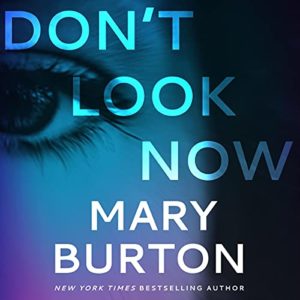Narrated by Hilary Huber, Alan Carlson, Kirt Graves, Heather Firth, Zara Eden & Joyce Oben
Mary Burton’s Don’t Look Now is a standalone suspense/police procedural novel in which a homicide detective has to confront the possibility that the serial killer she’s now trying to apprehend may be the same person who assaulted her younger sister a couple of years earlier. The book gets off to a bit of a slow start and I almost put it aside to return to later, but it picked up after a few chapters and became a lot more interesting.
We’re plunged right in to the deranged world of the serial killer in the prologue, which depicts the gruesome assault and death of their latest victim. It’s not blood-and-guts gory and I’m not squeamish, but I did find it made for uncomfortable listening. I’m sure that was the intention, but I’m starting to become tired of the way so many thrillers use sickening violence against women as a basic premise. That’s a different issue however and I’m not going to discuss it here; I chose to listen to Don’t Look Now knowing the storyline and I’m not going to diss it on account of a plot point I knew about in advance.
Austin-based Homicide detective Jordan Poe (a Boston transplant) is tough, hard-working and good at her job, although she’s not going to win any prizes for the warmth of her personality. But so be it – she does what she needs to do to get results and get the job done. Her life hasn’t been an easy one; after the death of her drug-addicted mother from an overdose, Jordan was left to bring up her younger sister Avery, having to cope with her sister’s grief as well as her own, and then later the fact that Avery had followed their mother’s path into addiction. After a couple of periods of rehab and relapse, Avery hit rock bottom and is only still alive because Jordan found her at her drug dealer’s place, her hands bound, her head covered with a plastic bag and freed her before Avery suffocated to death. Avery has been sober ever since and is doing really well, but Jordan can’t help worrying about her and looking out for signs of relapse.
When a young woman is found dead, her body wrapped in plastic sheeting, her hands bound, her head encased in a plastic bag, it’s impossible for Jordan not to be reminded of what happened to her sister. When a second body is discovered, bound and wrapped in exactly the same way, she has to wonder if the murders are somehow related to Avery’s assault. The victims certainly bear a physical resemblance to Avery, and they also had a history of substance abuse. Was her sister some kind of practice run for the killer?
Jordan’s investigation is just getting under way when her boss informs her that he’s handing the case over to the Texas Rangers. He insists it’s because the Rangers are much better funded and resourced, but Jordan knows it’s really because he doesn’t want any bad publicity should the killer not be identified and apprehended quickly. Quietly fuming, she liaises with Texas Ranger Carter Spenser, and has to admit – begrudgingly – that he is at least highly experienced and competent, and is surprised when he is prepared to listen to her and take her opinions into account. When Jordan receives a phone call from the killer’s latest victim, Carter is her first call for help; she alerts him and then races to the location obtained from the phone’s GPS signal, desperate to help the terrified young woman. She knows she should wait for backup, but Jordan also knows she has only a small window of opportunity to effect a rescue. Carter has still not arrived when she decides to enter the location and get the young woman out – but before she’s able to do that, Jordan is struck on the back of the head and badly injured.
From here on in, the story – while still focused on the serial killer plotline – broadens out to encompass Jordan’s relationship with Avery and the gradually evolving trust and friendship between Jordan and Carter, as Jordan struggles to come to terms with the fact that the blow to the head damaged her optic nerve and has significantly impaired her vision. These interpersonal relationships together with Jordan’s very realistic reactions to the almost total loss of her sight were what kept me engaged; the suspense plot is fine, but nothing I haven’t heard before, and even though I wanted to know how things would resolve, I’d worked out the identity of the villain well before the end. I really liked Avery, who is determined to keep her life on track but also determined to get on with the process of living it, and although Jordan’s concern sometimes feels a bit suffocating, it’s clear it comes from a good place.
Mary Burton’s books are usually categorised as romantic suspense, but there’s no real romance in this one – we’re told Jordan and Carter are attracted to each other and they do get it on (behind closed doors) late in the story, but there’s no romantic spark there, and I much preferred the mutual respect and understanding they display as friends.
One of the things that caught my eye about Don’t Look Now was the fact that it appeared to be what is generally termed a “full cast recording” – something I’ve only seen in contemporary romance so far. However, that was a mistaken assumption; in a full cast recording, each narrator performs one character throughout the book, but what happens here is that each of the narrators reads chapters/sections from the different PoVs in the book and portrays all the characters in those chapters. (Rather like a dual narration, but with seven PoV characters instead of two!) Thus, Hillary Huber (who I’m guessing is the principal female narrator – there’s no cast list provided) reads all the chapters from Jordan’s perspective and portrays all the characters who appear in those chapters. This isn’t a terrible idea, but it would have worked better if Brilliance had chosen female narrators who sound significantly different from each other; most of the time, I only realised the PoV had changed because of what was in the text as the women’s voices all sound so similar. The two male narrators are easy to tell apart, however – Kirt Graves is the only one of these narrators I’m familiar with, so by a process of elimination, I could tell that Alan Carlson reads Carter’s PoV.
I haven’t listened to Hillary Huber before, although I know she’s a very experienced narrator. She does a decent enough job here, but her pacing is quite slow and in the first few chapters, she sounds bored. She also attempts to adopt a Bostonian accent (dropping the rhotic R so “car” is “caa” etc.) but it’s intermittent and – to my English ears – sounds phony. (Reviews at Audible.com by, I’m guessing, American listeners, say the same thing.) Her performance did grow on me, though, and once I’d got used to the odd accent and slower pacing, I was able to start to enjoy the story more. Alan Carlson is new-to-me as well (although I’m sure I’ve heard him before, maybe under another name?) and I liked his performance from his very first appearance; he’s got an attractive, slightly gravelly voice which worked well to portray a forty-something, been-around-the-block-a-few-times career cop.
Don’t Look Now is unlikely to be an audiobook I’ll listen to again, but on balance, I enjoyed it, especially the exploration of the dynamic between the sisters and of the challenges Jordan faces as the result of her injury. The multi-narrator idea was a good one, but it would have worked better with a wider variety of tone and timbre in the female voices.
Note: This title contains frequent references to drug addiction and includes scenes featuring drug use and sexual assault.
Caz
Buy Don't Look Now by Mary Burton on Amazon





1 thought on “Don’t Look Now by Mary Burton”
Comments are closed.